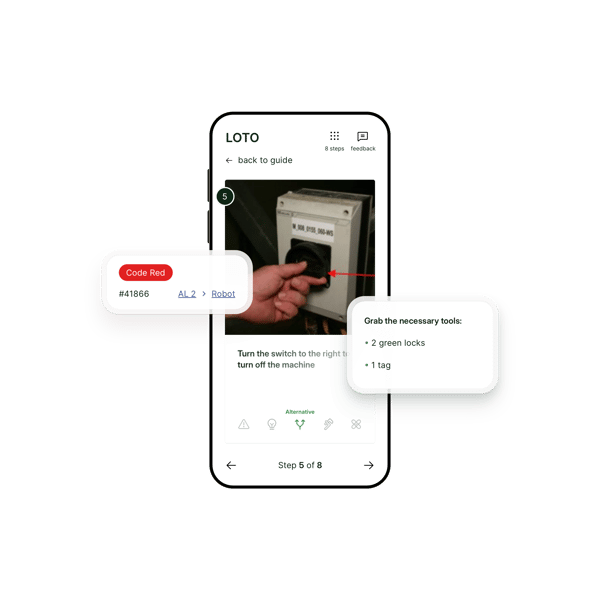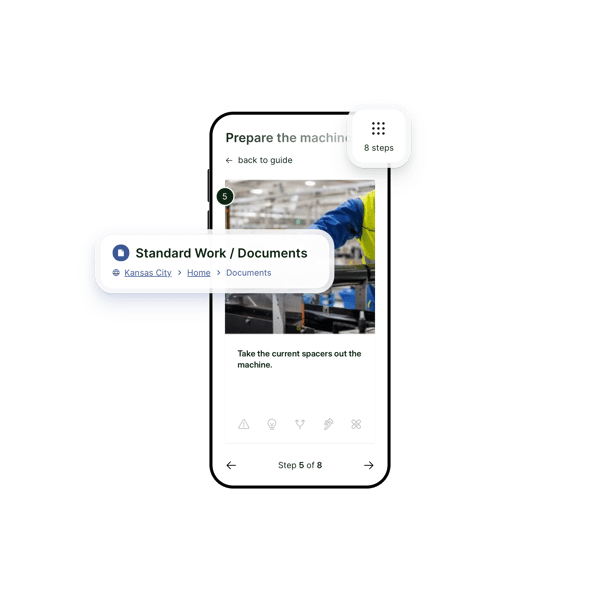

Better Upskilling and Training Content: 4 Examples for the Frontline
Here’s how to use effective training content (with examples) to improve task execution and knowledge retention at the frontline.
Improving upskilling and training content - leading and learning by example.
You can have the most ambitious training goals and programs in place for your frontline teams.
But they’re not going to be effective unless they’re reaching the right people, in the right format, at the right moment in time.
Training content for the frontline has taken many shapes and forms over the past two centuries. Examples include apprenticeships, to paper instructions, to digital training platforms.
Regardless of the format, one of the most important elements of training your frontline and ensuring consistent, high-quality work, is choosing the right training content to fill the right need.
There are some constants in the world of training content! Everything you deliver on the shop floor (and beyond) needs to be:

Below, we’ll outline 4 examples of effective training content for manufacturing, with a real-world use case at the end.
1. Visual standard work with digital job aids.
Giving learners accessible, visual, step-by-step job aids in the moment of need helps them learn on-the-job.
Content: Training based on step-by-step visual work instructions and SOPs, dual-coded with clear visuals of the task at hand. This method focuses on ensuring consistent execution of critical tasks and ‘just-in-time’ training.
Skills learned: Machine inspection, changeover procedure, CILT (cleaning, inspection, lubrication, tightening), safety checks, 5S tasks, quality checks. This content is ideal for routine work where downtime is a critical factor.
Delivery: The best SOPs are delivered directly to mobile devices during the flow of work on the shop floor. Teams simply scan QR codes on machines and link directly to the relevant knowledge.

Break real tasks into discrete steps to allow teams to follow along step-by-step in the flow of work.
Benefits:
- Improves understanding and retention of complex procedures.
- Reduces errors and ensures consistency in operations.
- Dramatically reduces time-to-effectiveness for new recruits.
- Addresses the "just-in-time" learning need and moves training content from the classroom to the production line.
- Employees can quickly access information during the flow of work, reinforcing proper procedures and reducing downtime.

These job aids are the ideal medium to digitize routine checks on the shop floor. Users can compare their work to a standard and instantly flag deviations.
Risks:
- It’s essential that SOPs be digitized in order to be effective in 2025. Without a digital system to ensure accuracy and availability, knowledge gets lost in a binder.
- Work instructions need to be well-crafted in order to be effective. Poorly written training content doesn’t help anyone learn!
2. Interactive events for complex skills.
Content: Hands-on simulations that replicate real-world scenarios encountered on the production line.
Skills learned: Troubleshooting equipment malfunctions, optimizing production flow, or responding to quality control issues. Learners make decisions within a controlled environment and see the consequences of their actions.
Delivery: Desktop computers, dedicated training stations, or even mock-production environments. These modules can even be delivered through VR or AR for more immersive experiences.
Benefits:
- Provides a safe environment to practice problem-solving skills without disrupting production.
- Allows employees to learn from mistakes without real-world consequences.
Promotes critical thinking and decision-making abilities.
Risks:
- Simulating a production environment at any scale can be time consuming and expensive, but often worth the investment.
- Make sure that you conduct enough research through change management initiatives to identify goals, risks, and opportunities before investing in these solutions.
3. Hands-on workshops with expert demonstrations.
Most training experts will argue that often there is no substitute for hands-on, expert-led, human training experiences in the production environment.
Content: In-person training sessions led by experienced technicians or supervisors.
Skills learned: Practical and nuanced skills like welding, assembly, or advanced machine operation that require deep knowledge and a human touch.
Delivery: Dedicated training area or directly on the production floor during scheduled downtime.
 Learning is still often best accomplished with an expert and a student interacting in the flow of work.
Learning is still often best accomplished with an expert and a student interacting in the flow of work.
Benefits:
- Enables direct interaction with experts and personalized feedback.
- Allows for immediate clarification of doubts and reinforces proper techniques through hands-on practice.
- Builds teamwork and communication skills with a human-focused experience.
Risks:
- Senior employees won’t always be available to offer this support and training - they’ve got their own work to do. Choose the right moment to involve them.
4. Microlearning content modules.
Content Types: Interactive modules or short (3-5 minute) videos hosted within an LMS, focusing on specific aspects of machine operation.
Examples: Proper startup and shutdown procedures, basic maintenance tasks (lubrication, filter changes), troubleshooting common errors, and safety precautions.
Delivery: This content has traditionally been delivered on desktop computers as part of “back-office” training. However, modern micro-learning can be offered as a mobile-first solution, with modules available on smartphones and tablets.
Benefits:
- Employees can quickly access information and learn at their own pace, reinforcing proper procedures and task execution.
- Bite-sized format improves retention and engagement over more traditional kinds of classroom training.
Risks:
- Video-based training content isn’t as effective for on-the-job training. It often produces a “lock-in effect” that stalls productivity.
- Not all LMS software is created equal! Make sure your solution integrates well with your other operational software and includes opportunities for other kinds of training content.
Training content example: Digital work instructions integrated into a CMME platform.
1. Accessing work instructions directly from a digital work order.
Users can access intuitive visual training materials at the moment of need for consistent process execution.
Example: There's a Code Red work order for the mechanical failure of a robot. A reference immediately pops up on an operator's smartphone with a step-by-step guide for performing the fix.
→ Access bite-sized, visual, step-by-step instructions directly in the flow of work
→ Eliminate the need to reference paper or PDF work instructions
→ Operators perform tasks correctly and reduce human error

2. Access work instructions from an operator portal.
Give teams the ability to search a library of relevant instructions directly in the same operator portal that they use every day.
Example: An operator gets a task to “set up the Multipacker” but doesn’t recall how to do it. They can:
→ Access from a digital repository of all work instructions and SOPs
→ Review the step-by-step procedure
→ ... and successfully execute the task!

3. Access work instructions directly from a checklist.
Frontline teams will often need to access training materials while performing routine quality, maintenance, and safety checks with a digital checklist.
→ Access work instructions and SOPs directly from the relevant step in a checklist
→ Operators use this guided knowledge to correctly perform a task, record a value, measure, clean, etc.
→ Immediately flag any variances or problems and create a work order directly within the flow of work
Want more training content?
👉 Here's how to train based on competency, not job titles.
👉 Here's a great free template to help coordinate employee development.
👉 Here's a breakdown of reskilling vs. upskilling (and the importance of each) at the frontline.
Author
Revisions
It's time to simplify frontline training
Work instructions, checklists, and skills management - all in SwipeGuide
- Cut training time by 50%
- SOC I and II compliant
Get to know us
SCHEDULE YOUR DEMOResources
-
1
How to empower your frontline with better instructional design. -
2
How to gain the edge in Industry 4.0 with smart manufacturing practices. -
3
How to make excellent digital work instructions. -
4
How to deliver continuous improvement at the frontline with Lean principles. -
5
How to capture, share, and improve expert knowledge with digital SOPs.


